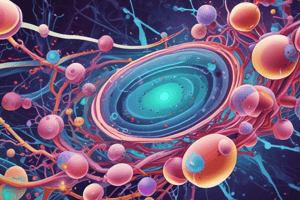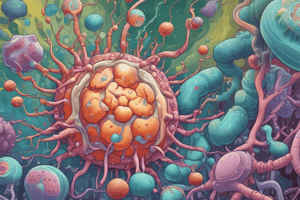Podcast
Questions and Answers
What is the main focus of Lecture 7 on Antibiotic resistance in Microbiology Bacteriology?
What is the main focus of Lecture 7 on Antibiotic resistance in Microbiology Bacteriology?
- Exploring the development of bacterial resistance to antibiotics (correct)
- Minimizing the impact of antibiotic resistance
- Understanding the mechanisms of antibiotic resistance
- Investigating bacterial adaptation to environmental changes
Based on the information provided, what is a key takeaway message regarding E.coli in the MEGA plate experiment?
Based on the information provided, what is a key takeaway message regarding E.coli in the MEGA plate experiment?
- Mutant strains of E.coli developed innate resistance to antibiotics
- E.coli had an inherent resistance to the antibiotic used in the experiment
- Initial mutations in E.coli led to enhanced growth rates
- Bacteria adapted to antibiotics exhibit normal growth rates (correct)
Which of the following best describes the concept of antibiotic resistance as mentioned in the text?
Which of the following best describes the concept of antibiotic resistance as mentioned in the text?
- Antibiotic resistance leads to faster growth rates in bacteria
- Microbes adapt to antibiotics by becoming more vulnerable
- Antibiotic resistance renders previously susceptible microbes unaffected by antibiotics (correct)
- A microbe's susceptibility to antibiotics remains constant over time
Which of the following is NOT mentioned as a mechanism by which bacteria develop resistance to antibiotics?
Which of the following is NOT mentioned as a mechanism by which bacteria develop resistance to antibiotics?
What did the MEGA plate experiment reveal about bacterial adaptation to antibiotics?
What did the MEGA plate experiment reveal about bacterial adaptation to antibiotics?
According to CDC's 2019 report, how is antibiotic resistance defined?
According to CDC's 2019 report, how is antibiotic resistance defined?
What does Resistance Transfer Factor (RTF) contain?
What does Resistance Transfer Factor (RTF) contain?
How are Resistance (R) genes primarily transferred to other bacteria?
How are Resistance (R) genes primarily transferred to other bacteria?
What distinguishes Conjugation from Transformation and Transduction?
What distinguishes Conjugation from Transformation and Transduction?
What happens to costly plasmids in the absence of selection pressure?
What happens to costly plasmids in the absence of selection pressure?
Which method involves bacteria taking up naked DNA fragments from their surroundings?
Which method involves bacteria taking up naked DNA fragments from their surroundings?
'Fitness cost for plasmid retention' refers to:
'Fitness cost for plasmid retention' refers to:
What is the process of transferring genetic information from a bacteriophage to a bacterium called?
What is the process of transferring genetic information from a bacteriophage to a bacterium called?
Which bacterial species are mentioned in the text as naturally capable of uptaking whole plasmids?
Which bacterial species are mentioned in the text as naturally capable of uptaking whole plasmids?
What happens to DNA that is not integrated into the chromosome or a plasmid after being taken up by a bacterial cell?
What happens to DNA that is not integrated into the chromosome or a plasmid after being taken up by a bacterial cell?
Which type of transduction allows for an equal chance for any piece of the original bacteria's DNA to be packaged by the phage?
Which type of transduction allows for an equal chance for any piece of the original bacteria's DNA to be packaged by the phage?
In the process of transduction, what might happen if the infected bacterial cell contains antibiotic resistance genes?
In the process of transduction, what might happen if the infected bacterial cell contains antibiotic resistance genes?
What is the main function of enzymes produced by bacteria in relation to antibiotics?
What is the main function of enzymes produced by bacteria in relation to antibiotics?
Which enzyme degrades penicillins and cephalosporins by hydrolysing the β-lactam ring?
Which enzyme degrades penicillins and cephalosporins by hydrolysing the β-lactam ring?
How do aminoglycoside-modifying enzymes affect antibiotics?
How do aminoglycoside-modifying enzymes affect antibiotics?
What contributes to B.subtilis being very resistant to ampicillin?
What contributes to B.subtilis being very resistant to ampicillin?
How is the gene for β-lactamase transmitted among bacteria?
How is the gene for β-lactamase transmitted among bacteria?
When may the effect of β-lactamase on bacteria be lost?
When may the effect of β-lactamase on bacteria be lost?
What is the main difference between antibiotic tolerance and antibiotic persistence as described in the text?
What is the main difference between antibiotic tolerance and antibiotic persistence as described in the text?
In the context of minimizing the development of antibiotic resistance, why is it recommended to complete full courses of antibiotics?
In the context of minimizing the development of antibiotic resistance, why is it recommended to complete full courses of antibiotics?
How does administering two or more drugs simultaneously help in reducing the likelihood of resistance acquisition?
How does administering two or more drugs simultaneously help in reducing the likelihood of resistance acquisition?
How does limiting antibiotic use to essential cases help minimize antibiotic resistance development?
How does limiting antibiotic use to essential cases help minimize antibiotic resistance development?
What does MDK99.9 stand for in the context of bacterial survival mechanisms?
What does MDK99.9 stand for in the context of bacterial survival mechanisms?
What is the purpose of targeting multiple bacterial components simultaneously with different drugs to reduce resistance?
What is the purpose of targeting multiple bacterial components simultaneously with different drugs to reduce resistance?
Flashcards are hidden until you start studying




